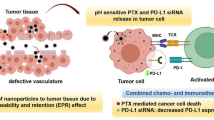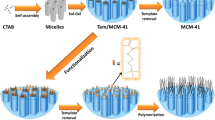Abstract
Target-specific drug delivery system that can transport an effective dosage of anti-cancer drugs to the targeted tumor cells can significantly reduce drug toxicity to the normal cells and increase the therapeutic effect of the drug. In our work, we have evaluated the cytotoxic potential of paclitaxel-loaded silica nanoparticles (Si-PTX NPs) prepared by template-directed stöber synthesis technique. The particles were characterized using transmission electron microscopy, scanning electron microscopy, and X-ray photoelectron spectroscopy. We have modified the surface of the drug-loaded particles chemically and conjugated a tumor-specific aptamer (Apt-Si-PTX NPs) to facilitate targeted drug delivery to the cancer cells. In vitro studies carried out demonstrated that the aptamer-conjugated paclitaxel-loaded silica nanoparticles could target the cancer cells with high specificity and destroy them effectively, while sparing the normal cells. This work concludes that the aptamer-tagged paclitaxel-loaded silica nanoparticles are excellent targeting moieties for targeted drug delivery to tumor cells.








Similar content being viewed by others
References
Yang, Y. W. (2011). Towards biocompatible nanovalves based on mesoporous silica nanoparticles. Medicinal Chemistry Communications. doi:10.1039/C1MD00158B.
Liu, D., He, X., Wang, K., He, C., Shi, H., Jian, L. (2010). Biocompatible silica nanoparticles—Insulin conjugates for mesenchymal stem cell adipogenic differentiation. Bioconjugate Chemistry, 21, 1673–1684.
Vivero-Escoto, J. L., Slowing, I. I., Trewyn, B. G., Lin, V. S.-Y. (2010). Mesoporous silica nanoparticles for intracellular controlled drug delivery. Small, 6, 1952–1967.
Lin, Y.-S., Tsai, C.-P., Huang, H.-Y., et al. (2005). Well ordered mesoporous silica nanoparticles as cell markers. Chem mate, 17(18), 4570–4573.
Santra, S., Yang, H., Dutta, D., et al. (2004). TAT conjugated, FITC doped silica nanoparticles for bioimaging applications. Chemical Communications, 24, 2810–2811.
Mal, N., Fujiwara, M., Tanaka, Y., et al. (2003). Photocontrolled reversible release of guest molecules from coumarin-modified mesoporous silica. Nature, 421, 350–353.
He, X., Duan, J., Wang, K., Tan, W. (2004). A novel fluorescent label based on organic dye-doped silica nanoparticles for HepG liver cancer cell recognition. Journal of Nanoscience and Nanotechnology, 4, 585–589.
Liong, M., Lu, J., Kovochich, M., et al. (2008). Multifunctional inorganic nanoparticles for imaging. Targeting, and drug delivery. ACS Nano, 2, 889–896.
Ferris, D. P., Lu, J., Gothard, C., et al. (2011). Synthesis of biomolecule-modified mesoporous silica nanoparticles for targeted hydrophobic drug delivery to cancer cells. Small, 7, 1816–1826.
Xing, Z.-C., Chang, Y., Kang, I.-K. (2010). Immobilization of biomolecules on the surface of inorganic nanoparticles for biomedical applications. Science and Technology of Advanced Materials, 11, 14101.
Sara, B., Genovese, D., Juris, R., et al. (2011). Luminescent silica nanoparticles: Extending the frontiers of brightness. Angewandte Chemie, 50, 4056–4066.
Rosen, J. E., & Gu, F. X. (2011). Surface functionalization of silica nanoparticles with cysteine: A low-fouling Zwitterionic surface. Langmuir, 27, 10507–10513.
Nair, R., Poulose, A. C., Nagaoka, Y., et al. (2011). Uptake of FITC labeled silica nanoparticles and quantum dots by rice seedlings: Effects on seed germination and their potential as biolabels for plants. Journal of Fluorescence. doi:10.1007/s10895-011-0904-5.
Veeranarayanan, S., Cheruvathoor, A. P., Mohamed, S., et al. (2011). FITC labeled silica nanoparticles as efficient cell tags: Uptake and photostability study in endothelial cells. Journal of Fluorescence. doi:10.1007/s10895-011-0991-3.
Yuan, H. (1998). Studies on the chemistry of paclitaxel. (Unpublished doctoral dissertation). Virginia polytechnic institute and state university, Virginia, United States
Honore, S., Pasquier, E., Braguer, D. (2005). Understanding microtubule dynamics for improved cancer therapy. Cellular and molecular life sciences: CMLS, 62(24), 3039–3056. doi:10.1007/s00018-005-5330-x.
Schiff, P. B., Fant, J., Horwitz, S. B. (1979). Promotion of microtubule assembly in vitro by taxol. Nature, 277, 665–667.
Parness, J., & Horwitz, S. B. (1981). Taxol binds to polymerized tubulin in vitro. The Journal of Cell Biology, 91, 479–487.
Jang, S. H., Wienties, M. G., Au, J. L. (2001). Determinants of paclitaxel uptake, accumulation and retention in solid tumors. Investigational New Drugs, 19, 113–123.
Woods, C. M., Zhu, J., McQueney, P. A., et al. (1995). Taxol-induced mitotic block riggers rapid onset of a p53-independent apoptotic pathway. Molecular Medicine, 1, 506–526.
Lanni, S. J., Lowe, S. W., Licitra, E. J., et al. (1997). p53-independent apoptosis induced by paclitaxel through an indirect mechanism. Proceedings of the National Acadcademy Science U S A, 94, 9679–9683.
Ozalp, V. C., Eyidogan, F., Oktem, H. A. (2011). Aptamer-gated nanoparticles for smart drug delivery. Review Literature and Arts of The Americas, 1137–1157. doi:10.3390/ph4081137.
Brewer, E., Coleman, J., Lowman, A. (2011). Emerging technologies of polymeric nanoparticles in cancer drug delivery. Journal of Nanomaterials, 2011, 1–10. doi:10.1155/2011/408675.
Mairal, T., Ozalp, V. C., Lozano Sánchez, P., Mir, M., Katakis, I., O’Sullivan, C. K. (2008). Aptamers: Molecular tools for analytical applications. Analytical and Bioanalytical Chemistry, 390(4), 989–1007. doi:10.1007/s00216-007-1346-4.
Yun, X-ying. (2008). 3-doped silica nanoparticle aptasensor for detection of thrombin based on electrogenerated chemiluminescence. Science and Technology, 20675031, 315–320.
Soundararajan, S., Spicer, E. K., Courtenay-luck, N., Fernandes, D. J., Plc, A. (n.d.). AS1411 inhibits the stabilization of bcl-2 mRNA by nucleolin in human breast cancer cells. Time, 1411–1411. http://www.investis.com/antisoma/posters/aacr07poster.pdf
Soundararajan, S., Wang, L., Sridharan, V., Chen, W., Courtenay-luck, N., Jones, D., Spicer, E. K., et al. (2009). Plasma membrane nucleolin is a receptor for the anticancer aptamer AS1411 in MV4-11 leukemia cells. Leukemia & Lymphoma, 76(5), 984–991. doi:10.1124/mol.109.055947.
Jim, E., & L, D. (2011). Aptamers: Turning the spotlight on cells. doi:10.1002/wnan.133.
Ray, P., & White, R. R. (2010). Aptamers for targeted drug delivery. Pharmaceuticals, 3(6), 1761–1778. doi:10.3390/ph3061761.
Ireson, C. R., & Kelland, L. R. (2006). Discovery and development of anticancer aptamers. Molecular Cancer Therapeutics, 5(12), 2957–2962. doi:10.1158/1535-7163.MCT-06-0172.
Sokolov, K., Follen, M., Aaron, J., Pavlova, I., Malpica, A., Lotan, R., Richards-kortum, R. (2004). Advances in brief real-time vital optical imaging of precancer using anti-epidermal growth factor receptor antibodies conjugated to gold nanoparticles 1. Cancer Research, 63, 1999–2004.
Ikanovic, M., Rudzinski, W. E., Bruno, J. G., Allman, A., Carrillo, M. P., Dwarakanath, S., Bhahdigadi, S., Rao, P., Kiel, J. L., Andrews, C. J. (2007). Fluorescence assay based on aptamer-quantum dot binding to Bacillus thuringiensis spores. Journal of Fluorescence, 17(2), 193–199.
Bruno, J. G., Phillips, T., Carrillo, M. P., Crowell, R. (2009). Plastic-adherent DNA aptamer-magnetic bead and quantum dot sandwich assay for Campylobacter detection. Journal of Fluorescence, 19(3), 427–435.
Bhattacharya, D., Das, M., Mishra, D., Banerjee, I., Sahu, S. K., Maiti, T. K., Pramanik, P. (2011). Folate receptor targeted, carboxymethyl chitosan functionalized iron oxide nanoparticles: A novel ultradispersed nanoconjugates for bimodal imaging. Nanoscale, 3, 1653–1662.
Fan J., Fang G., Wang X., Zeng F., Xiang Y., Wu S. (2011) Targeted anticancer prodrug with mesoporous silica nanoparticles as vehicles. Nanotechnology, 22, 455102 (11 pp) doi:10.1088/0957-4484/22/45/455102.
De Souza, R., Zahedi, P., Allen, C. J., Piquette-Miller, M. (2009). Biocompatibility of injectable chitosan—Phospholipid implant systems. Biomaterials, 30, 3818–3824.
Yu, C., Hu, Y., Duan, J., Yuan, W., Wang, C., Xu, H., Yang, X. (2011). Novel aptamer-nanoparticle bioconjugates enhances delivery of anticancer drug to MUC1-positive cancer cells in vitro. PLoS One, 6(9), e24077. doi:10.1371/journal.pone.0024077.
Acknowledgment
Athulya Aravind, Srivani Veeranarayanan, and Aby Cheruvathoor Poulose thank the Ministry of Education, Culture, Sports, Science, and Technology (MEXT), Japan for the financial support given as Monbukagakusho fellowship.
Author information
Authors and Affiliations
Corresponding author
Additional information
Athulya Aravind and Srivani Veeranarayanan contributed equally to this work.
Rights and permissions
About this article
Cite this article
Aravind, A., Veeranarayanan, S., Poulose, A.C. et al. Aptamer-Functionalized Silica Nanoparticles for Targeted Cancer Therapy. BioNanoSci. 2, 1–8 (2012). https://doi.org/10.1007/s12668-011-0029-y
Published:
Issue Date:
DOI: https://doi.org/10.1007/s12668-011-0029-y




